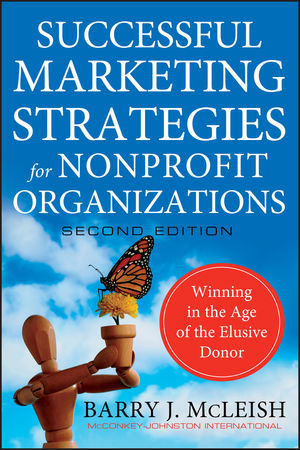Successful Marketing Strategies for Nonprofit Organizations: Winning in the Age of the Elusive Donor, 2nd EditionISBN: 978-0-470-52981-2
Hardcover
288 pages
November 2010
 This is a Print-on-Demand title. It will be printed specifically to fill your order. Please allow an additional 10-15 days delivery time. The book is not returnable.
|
||||||
Preface xv
Acknowledgments xxxi
Part I Introduction 1
Chapter 1 A New Way of Doing Business for the Nonprofit Organization 3
The Need for a New Marketing Orientation 4
Dealing with Nonprofit Organizations in Flux 5
Marketing to the External World 10
Marketing Defined 10
Develop an Outline of Marketing Strategies 13
The Marketing Task 18
Marketing Tools 22
Use Distinctive Competencies to Assess the Competition 26
Summary 27
Chapter 2 The Development of a Marketing Strategy 29
Why a Marketing Strategy? 31
First Steps in Defining Strategy 33
The Operating Environment’s Effects on Marketing Strategy 38
First Steps to a Competitive Strategy 47
Breaking with Tradition to Remain Flexible 48
Summary 49
Chapter 3 The Phased Strategic Marketing Plan 51
External-Analysis Phase 52
Internal-Analysis Phase 56
Market-Development Phase 57
Strategy-Selection Phase 59
Presentation of the Plan 59
Summary 60
Part II The External Analysis 61
Chapter 4 External Analysis: Client, Donor, Volunteer, and Competitor Research 63
The Importance of Continuous Listening and Analysis 65
Building a Rationale and Addressing Objections to Stakeholder Listening and Research 66
Other Research and Listening Concerns, Including Flexibility 71
Start with Clients, Volunteers, Constituents, Customers, and Donors 72
Segmentation as the Next Step 73
Enduring and Dynamic Segmentation Variables 74
Describing Clients, Donors, Volunteers, Customers, and Constituents 81
Additional Segmentation Strategies Following an External Audit 83
External Analysis of Competitors 84 Positioning to Understand ‘‘the Market’’ 87
Ways to Identify Competition 87
How Nonprofit Organizations Compete 88
Summary 91
Chapter 5 Researching Your Nonprofit Organization’s Environment 93
The Nature of a Nonprofit Organization’s Environment 94
External Analysis, Competitors, and a Nonprofit’s Environment 95
The Actual and Potential Size of the Competitive Environment 96
How Is the Environment Structured? 98
How Nonprofit Organizations Enter an Industry 103
How Does the Nonprofit Organization Deliver Its Services? 106
What Is the Potential for Growth? 109
Relating Product Life Cycles to a Nonprofit’s Growth Potential 111
Differentiating a Nonprofit Based on External Analysis 113
Summary 117
Chapter 6 Competition and Internal Marketing Analysis 119
Reasons for an Internal Examination 120
Measuring Past and Current Performance 122
Dealing with Strategic Problems and Uncertainty 132
Assessing the Organization’s Strengths and Weaknesses 137
Looking for and Managing Long-Term Relationships 141
Cost and Performance Analysis Helps Define Success 143
The Internal Audit Helps Define Organizational Strengths and Weaknesses 144
Summary 145
Chapter 7 Value Propositions and Marketing Objectives 147
Would Anyone Miss You If You Went out of Business? 147
Why Should a Nonprofit Organization Worry about Objectives? 147
Developing Organizational Objectives 148
Using Objectives to Excel in Marketing 153
Marketing Performance Comes with Measuring Company Objectives 155
Staying Competitive 165
Summary 166
Chapter 8 Creating Competitive Advantage 167
Strategy Options 168
The Most Popular Strategic Orientations and Their Application to the Organization 172
Matching the Market 176
Tactics for Achieving Competitive Advantage 177
The Sustainable Competitive Advantage 178
What Constitutes a Sustainable Competitive Advantage 178
Augmenting Success 181
Market Strategies 182
Summary 185
Chapter 9 Winning through Competitive Strategy Options 187
The Nature of Strategy and Its Uses 188
Environmental Context and Strategic Options 191
Strategy Frameworks 193
Strategy Models 194
The Portfolio Framework 196
The Forces of Competition 198
Porter’s Three Competitive Strategies 202
The Planning Process Framework 203
Summary 205
Chapter 10 Creating a Competitive Image and Brand 207
Brand Formulation 208
Merging Brand and Strategy 211
Using the Brand Strategically 216
Reaching the Branded Goals of the Campaign 219
Summary 228
Epilogue 229
Notes 237
References 243
About the Author 245
Index 247



